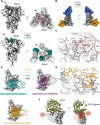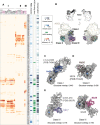This is a preprint.
Potent neutralizing nanobodies resist convergent circulating variants of SARS-CoV-2 by targeting novel and conserved epitopes
- PMID: 33758850
- PMCID: PMC7987009
- DOI: 10.1101/2021.03.09.434592
Potent neutralizing nanobodies resist convergent circulating variants of SARS-CoV-2 by targeting novel and conserved epitopes
Update in
-
Potent neutralizing nanobodies resist convergent circulating variants of SARS-CoV-2 by targeting diverse and conserved epitopes.Nat Commun. 2021 Aug 3;12(1):4676. doi: 10.1038/s41467-021-24963-3. Nat Commun. 2021. PMID: 34344900 Free PMC article.
Abstract
There is an urgent need to develop effective interventions resistant to the evolving variants of SARS-CoV-2. Nanobodies (Nbs) are stable and cost-effective agents that can be delivered by novel aerosolization route to treat SARS-CoV-2 infections efficiently. However, it remains unknown if they possess broadly neutralizing activities against the prevalent circulating strains. We found that potent neutralizing Nbs are highly resistant to the convergent variants of concern that evade a large panel of neutralizing antibodies (Abs) and significantly reduce the activities of convalescent or vaccine-elicited sera. Subsequent determination of 9 high-resolution structures involving 6 potent neutralizing Nbs by cryoelectron microscopy reveals conserved and novel epitopes on virus spike inaccessible to Abs. Systematic structural comparison of neutralizing Abs and Nbs provides critical insights into how Nbs uniquely target the spike to achieve high-affinity and broadly neutralizing activity against the evolving virus. Our study will inform the rational design of novel pan-coronavirus vaccines and therapeutics.
Figures







Similar articles
-
Potent neutralizing nanobodies resist convergent circulating variants of SARS-CoV-2 by targeting diverse and conserved epitopes.Nat Commun. 2021 Aug 3;12(1):4676. doi: 10.1038/s41467-021-24963-3. Nat Commun. 2021. PMID: 34344900 Free PMC article.
-
A Novel Nanobody Targeting Middle East Respiratory Syndrome Coronavirus (MERS-CoV) Receptor-Binding Domain Has Potent Cross-Neutralizing Activity and Protective Efficacy against MERS-CoV.J Virol. 2018 Aug 29;92(18):e00837-18. doi: 10.1128/JVI.00837-18. Print 2018 Sep 15. J Virol. 2018. PMID: 29950421 Free PMC article.
-
Escape from neutralizing antibodies by SARS-CoV-2 spike protein variants.Elife. 2020 Oct 28;9:e61312. doi: 10.7554/eLife.61312. Elife. 2020. PMID: 33112236 Free PMC article.
-
Identification of B-Cell Epitopes for Eliciting Neutralizing Antibodies against the SARS-CoV-2 Spike Protein through Bioinformatics and Monoclonal Antibody Targeting.Int J Mol Sci. 2022 Apr 14;23(8):4341. doi: 10.3390/ijms23084341. Int J Mol Sci. 2022. PMID: 35457159 Free PMC article. Review.
-
Applications of nanobodies in the prevention, detection, and treatment of the evolving SARS-CoV-2.Biochem Pharmacol. 2023 Feb;208:115401. doi: 10.1016/j.bcp.2022.115401. Epub 2022 Dec 30. Biochem Pharmacol. 2023. PMID: 36592707 Free PMC article. Review.
References
Publication types
Grants and funding
LinkOut - more resources
Full Text Sources
Other Literature Sources
Research Materials
Miscellaneous
